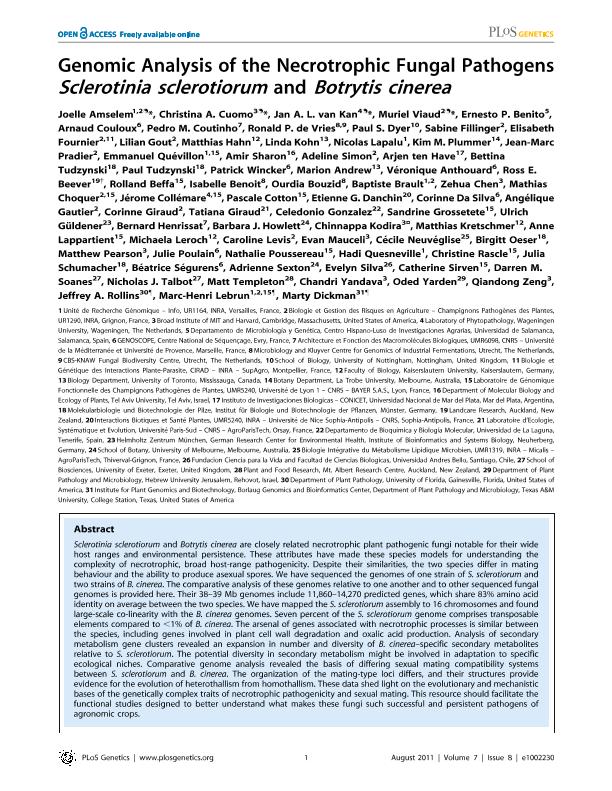Artículo
Genomic analysis of the necrotrophic fungal pathogens Sclerotinia sclerotiorum and Botrytis cinerea
Ten Have, Arjen ; Amselem, Joelle; Cuomo, Christina A.; Jan, A. L. van Kan; Viaud, Muriel; Benito, Ernesto P.; Couloux, Arnaud; Coutinho, Pedro M.; Vries, Ronald P. de; Dyer, Paul S.; Fillinger, Sabine; Fournier, Elisabeth; Gout, Lilian; Hahn, Matthias; Kohn, Linda; Lapalu, Nicolas; Plummer, Kim M.; Pradier, Jean-Marc; Quévillon, Emmanuel; Sharon, Amir; Simon, Adeline; Tudzynski, Bettina; Tudzynski, Paul; Wincker, Patrick; Andrew, Marion; Anthouard, Véronique; Beever, Ross E.; Beffa, Rolland; Benoit, Isabelle ; Bouzid, Ourdia
; Amselem, Joelle; Cuomo, Christina A.; Jan, A. L. van Kan; Viaud, Muriel; Benito, Ernesto P.; Couloux, Arnaud; Coutinho, Pedro M.; Vries, Ronald P. de; Dyer, Paul S.; Fillinger, Sabine; Fournier, Elisabeth; Gout, Lilian; Hahn, Matthias; Kohn, Linda; Lapalu, Nicolas; Plummer, Kim M.; Pradier, Jean-Marc; Quévillon, Emmanuel; Sharon, Amir; Simon, Adeline; Tudzynski, Bettina; Tudzynski, Paul; Wincker, Patrick; Andrew, Marion; Anthouard, Véronique; Beever, Ross E.; Beffa, Rolland; Benoit, Isabelle ; Bouzid, Ourdia
 ; Amselem, Joelle; Cuomo, Christina A.; Jan, A. L. van Kan; Viaud, Muriel; Benito, Ernesto P.; Couloux, Arnaud; Coutinho, Pedro M.; Vries, Ronald P. de; Dyer, Paul S.; Fillinger, Sabine; Fournier, Elisabeth; Gout, Lilian; Hahn, Matthias; Kohn, Linda; Lapalu, Nicolas; Plummer, Kim M.; Pradier, Jean-Marc; Quévillon, Emmanuel; Sharon, Amir; Simon, Adeline; Tudzynski, Bettina; Tudzynski, Paul; Wincker, Patrick; Andrew, Marion; Anthouard, Véronique; Beever, Ross E.; Beffa, Rolland; Benoit, Isabelle ; Bouzid, Ourdia
; Amselem, Joelle; Cuomo, Christina A.; Jan, A. L. van Kan; Viaud, Muriel; Benito, Ernesto P.; Couloux, Arnaud; Coutinho, Pedro M.; Vries, Ronald P. de; Dyer, Paul S.; Fillinger, Sabine; Fournier, Elisabeth; Gout, Lilian; Hahn, Matthias; Kohn, Linda; Lapalu, Nicolas; Plummer, Kim M.; Pradier, Jean-Marc; Quévillon, Emmanuel; Sharon, Amir; Simon, Adeline; Tudzynski, Bettina; Tudzynski, Paul; Wincker, Patrick; Andrew, Marion; Anthouard, Véronique; Beever, Ross E.; Beffa, Rolland; Benoit, Isabelle ; Bouzid, Ourdia
Fecha de publicación:
08/2011
Editorial:
Public Library of Science
Revista:
Plos Genetics
ISSN:
1553-7390
Idioma:
Inglés
Tipo de recurso:
Artículo publicado
Clasificación temática:
Resumen
Sclerotinia sclerotiorum and Botrytis cinerea are closely related necrotrophic plant pathogenic fungi notable for their wide host ranges and environmental persistence. These attributes have made these species models for understanding the complexity of necrotrophic, broad host-range pathogenicity. Despite their similarities, the two species differ in mating behaviour and the ability to produce asexual spores. We have sequenced the genomes of one strain of S. sclerotiorum and two strains of B. cinerea. The comparative analysis of these genomes relative to one another and to other sequenced fungal genomes is provided here. Their 38–39 Mb genomes include 11,860–14,270 predicted genes, which share 83% amino acid identity on average between the two species. We have mapped the S. sclerotiorum assembly to 16 chromosomes and found large-scale co-linearity with the B. cinerea genomes. Seven percent of the S. sclerotiorum genome comprises transposable elements compared to <1% of B. cinerea. The arsenal of genes associated with necrotrophic processes is similar between the species, including genes involved in plant cell wall degradation and oxalic acid production. Analysis of secondary metabolism gene clusters revealed an expansion in number and diversity of B. cinerea–specific secondary metabolites relative to S. sclerotiorum. The potential diversity in secondary metabolism might be involved in adaptation to specific ecological niches. Comparative genome analysis revealed the basis of differing sexual mating compatibility systems between S. sclerotiorum and B. cinerea. The organization of the mating-type loci differs, and their structures provide evidence for the evolution of heterothallism from homothallism. These data shed light on the evolutionary and mechanistic bases of the genetically complex traits of necrotrophic pathogenicity and sexual mating. This resource should facilitate the functional studies designed to better understand what makes these fungi such successful and persistent pathogens of agronomic crops.
Palabras clave:
Gray Mould
,
White Mould
,
Genome Analysis
,
Genome Sequence
Archivos asociados
Licencia
Identificadores
Colecciones
Articulos(IIB)
Articulos de INSTITUTO DE INVESTIGACIONES BIOLOGICAS
Articulos de INSTITUTO DE INVESTIGACIONES BIOLOGICAS
Citación
Ten Have, Arjen; Amselem, Joelle; Cuomo, Christina A.; Jan, A. L. van Kan; Viaud, Muriel; et al.; Genomic analysis of the necrotrophic fungal pathogens Sclerotinia sclerotiorum and Botrytis cinerea; Public Library of Science; Plos Genetics; 7; 8; 8-2011; 1-27
Compartir
Altmétricas



